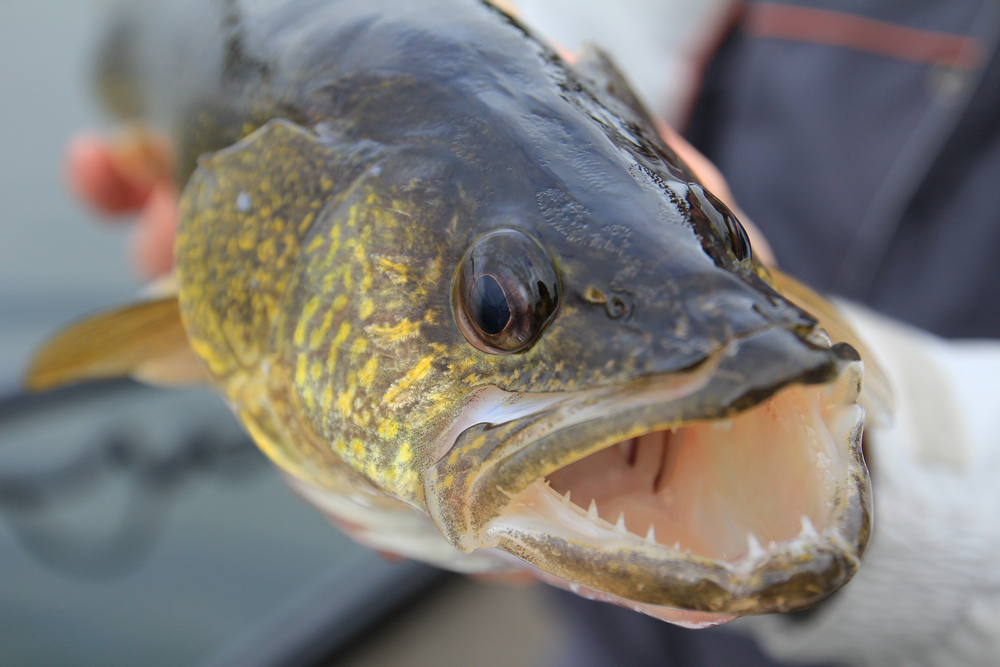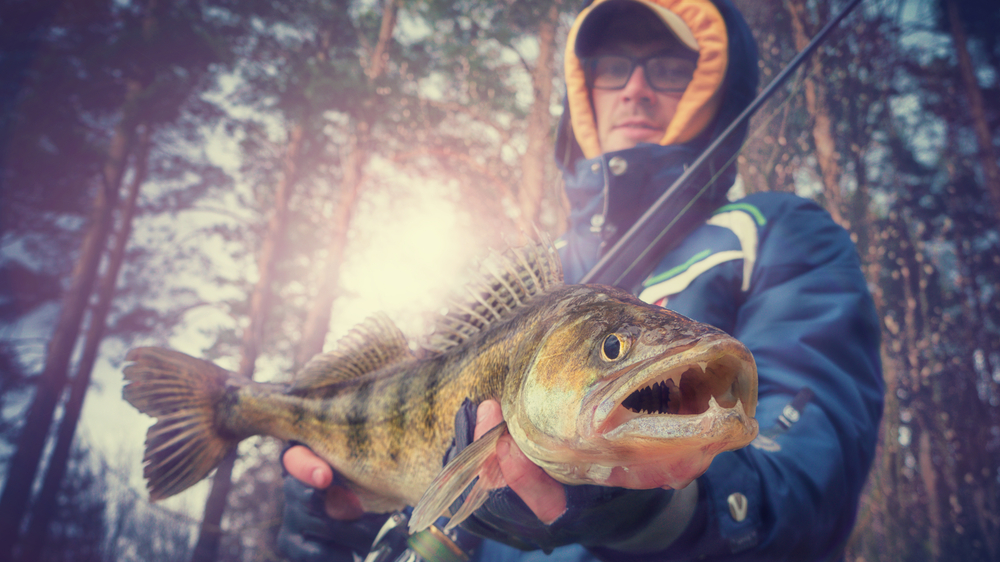Walleyes are so-called because their eyes are on the sides of their head, as though looking at the walls next to them.
These funny looking creatures are a freshwater fish native to Canada and North America.
They are a popular fish for sport and for eating and have long been a common catch for anyone fishing in lakes.
In today’s article, we will be diving a little deeper into the world of walleyes, looking in particular at their teeth.
After all, keen fishers will want to know whether they can get bitten by these fish and whether they need to enlist the help of a metal leader for their lines!
In this article, we will be letting you know some interesting facts about walleyes, looking at the following common queries; where exactly they can be found, what to expect if you catch one and whether they can bite you.
This is definitely a must-read for any keen angler or anyone with a fascination for fish as we will be telling you all about what we think is a very underrated creature.

What exactly is a walleye?
So, we have already established that the walleye is a freshwater fish that resides in North America and Canada.
Freshwater means that it resides in lakes rather than in the depths of the ocean. Because lakes often freeze over in cold weather, walleyes are also a common catch for ice-fishers.
This interesting water dweller is a favorite of anglers and is often caught to be cooked and eaten. In fact, it is something of a specialty in many of the lake-heavy areas of America and Canada.
In Minnesota, for example, it is often served deep-fried on a stick at the State Fair and in sandwiches at the pubs there.
It is also fished as a sport by keen lake fishers, many of whom practice ‘catch and release fishing’, putting their catch back in the water after they have taken their obligatory photo. For this reason, it is regulated by natural resource agencies.
Minnesota is so proud of their walleyes that they have statues dedicated to them in the towns surrounding various lakes, and they have even named it the state fish. Other states have done the same, namely South Dakota and Vermont.
The walleye is also known by its other names, yellow pike and yellow pickerel. However, it is less yellow in color, and more a sort of metallic olive or gold.
They are nocturnal fish, meaning that anglers will fish in the evening into the night for walleyes. In fact, they are most often caught at either dusk or dawn which is the time they start looking for food.
They are carnivorous fish, and so they tend to feed on smaller fish such as minnows. For this reason, fishermen often use minnows as lures for walleyes.
You would think that the fact they are nocturnal would make them very difficult to catch, due to the darkness of lower levels of light. However, this is not the case.
Their eyes are very similar to the eyes of a cat or lion, in that in the dark, you can see their eyes quite clearly. This is because they give off an eyeshine known as tapetum lucidum.
This is a layer in their eyes that allows the fish to see in low light - perfect when considering the nocturnal habits of the walleye. However, unlucky for the walleye, this gives anglers an advantage over them.
Anglers are often able to see a walleye because of this eyeshine, making it far easier to catch them even in darkness. It’s a sort of blessing and curse for the walleyes, then.
Do they have teeth?
You may well be very fascinated by now and want to head out to the lakes to see a walleye for yourself.
However, we are sure that something has stuck in your head, and may possibly be worrying you.
We mentioned that walleyes are carnivorous fish, and for many people, that is enough to scare them away forever. This may pose questions of “Do they have teeth?”, “can they eat me?”, and “will they eat my fishing line?”.
All of these questions are valid, and as far-fetched, as they may seem to some experienced anglers, for those who have never done it before it could be a genuine fear.
Let us ease your worries right away by telling you that a walleye will not swallow you whole. Walleyes are roughly around 31 inches in length and can weigh up to 20lbs. Much smaller than the average human, right?
Even the biggest walleye on record (42 inches long and 29lbs in weight) is much smaller than us.
That being said, as with most carnivorous fish, the walleye is in possession of teeth….and relatively sharp teeth at that!

Can a walleye bite hurt a human?
Now, before you start thinking about a Jaws-type scenario, we want to make clear that in general, walleyes are not known to be vicious fish.
Their teeth are there for the purpose of eating - hey, a fish gotta eat! Even in comparison to other fish, like their distant relative, the pike, their teeth are relatively small. They are more rounded than that of a pike and are not as long.
However, the teeth of a walleye are still sharp enough to pierce the skin of a human.
Whilst not as common as pike bites (Pike bites are very common, as pike are far more likely to attack a human and become vicious), there are times where walleye bites have occurred as the result of bait retrieval.
To clarify, there have been no known occurrences of a walleye attacking a human intentionally, but humans have certainly been bitten when putting their hands in the mouth of a walleye!
Before you start thinking “well, just don’t put your hands in their mouths!”, we should make the point that sometimes it is necessary to go into the mouth of your catch to retrieve the bait. Many brave anglers and fishermen have done it (and many have scars to show it).
Of course, if you have long enough fishing pliers, you can simply use these to remove the bait, but sometimes your bare hands are the only thing to hand.
In this case, a bite is certainly a possibility. As with a bite from any animal you should carefully clean it thoroughly, especially in areas where the skin has broken and blood has been drawn.
Walleyes, as with any fish, can be carriers of disease, and these diseases may live in their mouths. The last thing you want is to end up with a nasty infection and an antibiotic injection or IV.
You may also be wondering if the walleye can cause any damage to your line and whether you might need to use a metal leader.
A fair point, in our opinion. Luckily, the teeth of a walleye are likely to be too blunt to cut through your regular fishing line, and so it is highly unlikely that you will have a need for a metal leader when angling for walleye fish.
Can you avoid being bitten when catching a walleye?
Yes, it is certainly possible to avoid being bitten when you are fishing and happen to catch a walleye.
It is important first that you take note of the section above and realize that, generally, walleyes are not offensive creatures.
They are not violent and tend to only bite when a hand is placed in their mouths. However, it is also true that you should learn how to properly handle a walleye (and any other fish you catch) to ensure your safety.
As well as this, when you are fishing for sport rather than food, the most common method is that of catch and release, wherein the fish is not killed, but put back into the water.
For this reason, it is important that you know how to handle them properly so as not to cause damage.
Of course, we think the best way to do this is by using your hands as little as possible. You can use a landing net or a pair of lip grippers. These methods are less likely to cause damage to the fish and you will be less likely to end up being bitten.
However, if you really must use your hands, or you want to pose for a photo with your proud catch (hey, we’ve all done it!), you should follow our steps below, ensuring to be gentle when handling the walleye.
Smaller walleyes can be held at the back of their head. Rest your hand on their back and your other underneath from behind. This is so that their hand can’t move and your fingers won’t get bitten.
Bear in mind that, typically, the smaller the walleye, the sharper their teeth. Strange, we know, but logistically it makes sense. Because of their smaller frame, all of their parts are smaller.
In terms of pointed teeth, smaller means pointier...and of course, pointer means sharper. The teeth of larger walleyes are much more likely to be rounded off or at least blunted a little.
For bigger walleyes, holding them in the same way as a small walleye will be a little more tricky. We recommend that you try to hold them under the bottom of the gill cover.
To do this, slide your fingers under and you should feel able to pull them out of the water.
It is likely you will need to support the bigger fish with your other hand or arm, so you should put that under them from behind them, well away from their mouths.
It is important that you do not insert your fingers under the gill cover too harshly and that you do not put them in too far. Doing this could hurt the fish and even kill it.
Final Word
So, there you have it. Your informative guide telling you everything you need to know about walleyes.
We hope you have enjoyed our article about walleye teeth, and that you have learned some interesting facts about them.
It is certain that this freshwater fish with its glowing eyes is an interesting creature. We hope you enjoyed learning about them just as much as we enjoyed sharing our knowledge about them.
To reiterate, walleyes do indeed have teeth and they are certainly sharp enough to cut through human skin.
However, provided they are handled correctly, and that you don’t place your hand right into their mouths, you will be unlikely to sustain a bite from them. They are not known to be vicious fish and will not attack you (unlike the rowdy pike).
It is important that you always practice safe handling of anything you catch, at all times. Use tools to retrieve your fishing hooks from their mouths, and landing nets to pick them up.
However, if you are without these tools and if you really do need to put your hand in their mouth, be prepared to clean any bite wounds immediately, lest you wind up with a gross infection and a course of antibiotics.
So, whether you are about to set off on your first angling experience, or you are a self-confessed pro, we hope this article has taught you something new and prepared you for your first ever walleye catch!
Happy fishing!
- 10 Best Trolling Motor Batteries: Top AGM and Flooded Options - January 27, 2021
- Types of Fishing Lures - January 22, 2021
- 8 Best Batteries For Fish Finders - January 22, 2021
